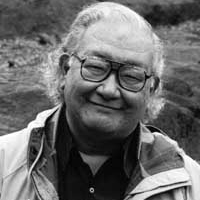Navarre Scott Momaday - Biography and Works
Navarre Scott Momaday is an American novelist, memoirist, and poet, who work in broad fields of Navy American history and cultural narrative. The range of Momaday’s works is underscored by his ability to fuse the experiences of opposing cultures in his writings, which convey a Native American world view founded on the principle of harmony in the universe. Born in Lawton, Oklahoma, Momaday is a member of the Kiowa tribe. He was educated at Stanford University.

N. Scott Momaday (Born in 1934)
He subsequently taught at Stanford from 1973 to 1982 and beginning in 1982, at the University of Arizona. He was a Guggenheim Fellow form 1966 to 1967. Momaday’s book House Made of Dawn tells the story of Abel, a veteran of World War II who lives in the modern world but is also linked through his imagination to legend and to the sacred storytelling of his Kiowa ancestry. Momaday’s memoir The Way to Rainy Mountain depicts the Kiowa tribe’s journey (about the beginning of the 18th century) from the Yellowstone River area to the Great Plains, where they became a society of hunters.
“The sky is our father. The earth is our mother.” This concept of nature, which is at the center of the Native American worldview, is familiar to all. But this concept may not be comprehensive to all in terms of ethical and philosophical implications. This comprehension of the earth and air is surely a matter of morality, because it brings into account not only a man’s instinctive reaction to his environment but the full realization of his humanity as well. Even if the Indian forgets or neglects his relationship with the land in time he will come to understand that there is an intimate, vital link between the earth and himself, a link that implies an intricate network of rights and responsibilities.
Momaday believes that his poetry, in particular, grows from and sustains the Indian oral tradition. He is only half-Kiowa, who grew up in New Mexico, where his mother, a teacher and writer, and his father, an artist and art teacher, found work among the Janez Indians in the state’s high canyon and mountain country, but he was originally raised among the Kiowa on a family farm in Oklahoma. Momaday prefers, like his mother, “to imagine himself all Indian and to imagine himself back into the life, the emotions, the spirit of his Kiowa for bears.” He uses English, his mother’s language, to tell “his story in the manner of his father’s people; moving freely back and forth in time and space, interweaving legend, myth, and history”. When he was less than a year old, Momaday was given the name Tsoaitalee or “Rocky-Tree-Boy” after the 200-foot volcanic butt in Wyoming, which is sacred to the Kiowa and is known to Anglo-Americans as Devil’s Tower. The Indian perception of the human relationship to nature is a central concern in Momaday’s writing. Although his work is rooted in the Native American literary tradition, it reveals broader influences. He writes in a plain style, frequently in an epigrammatic mode, often in rhyme and syllabics. Believing that “words are powerful beyond our knowledge” and contain an element of magic, he acknowledges their musicality through rhyme, assonance, and consonance.
Cite this Page!
Sharma, Kedar N. "Navarre Scott Momaday - Biography and Works." BachelorandMaster, 15 Nov. 2013, bachelorandmaster.com/biography/navarre-scott-momaday.html.
